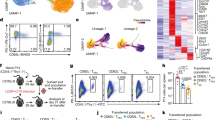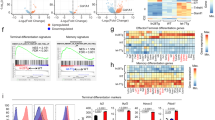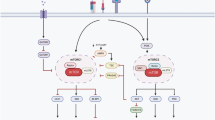Abstract
Antiviral CD8+ T cell responses are characterized by an initial activation/priming of T lymphocytes followed by a massive proliferation, subset differentiation, population contraction and the development of a stable memory pool. The transcription factor BATF3 has been shown to play a central role in the development of conventional dendritic cells, which in turn are critical for optimal priming of CD8+ T cells. Here we show that BATF3 was expressed transiently within the first days after T cell priming and had long-lasting T cell–intrinsic effects. T cells that lacked Batf3 showed normal expansion and differentiation, yet succumbed to an aggravated contraction and had a diminished memory response. Vice versa, BATF3 overexpression in CD8+ T cells promoted their survival and transition to memory. Mechanistically, BATF3 regulated T cell apoptosis and longevity via the proapoptotic factor BIM. By programing CD8+ T cell survival and memory, BATF3 is a promising molecule to optimize adoptive T cell therapy in patients.
This is a preview of subscription content, access via your institution
Access options
Access Nature and 54 other Nature Portfolio journals
Get Nature+, our best-value online-access subscription
$29.99 / 30 days
cancel any time
Subscribe to this journal
Receive 12 print issues and online access
$209.00 per year
only $17.42 per issue
Buy this article
- Purchase on Springer Link
- Instant access to full article PDF
Prices may be subject to local taxes which are calculated during checkout







Similar content being viewed by others
Data availability
The sequencing data are available at NCBI Gene Expression Omnibus (http://www.ncbi.nlm.nih.gov/geo) under accession numbers GSE143504 and GSE153341. The data that support the findings of this study are available from the corresponding authors upon request.
References
Kaech, S. M. & Cui, W. Transcriptional control of effector and memory CD8+ T cell differentiation. Nat. Rev. Immunol. 12, 749–761 (2012).
Bedoui, S., Heath, W. R. & Mueller, S. N. CD4+ T-cell help amplifies innate signals for primary CD8+ T-cell immunity. Immunol. Rev. 272, 52–64 (2016).
Eickhoff, S. et al. Robust anti-viral immunity requires multiple distinct T cell–dendritic cell interactions. Cell 162, 1322–1337 (2015).
Hor, J. L. et al. Spatiotemporally distinct interactions with dendritic cell subsets facilitates CD4+ and CD8+ T cell activation to localized viral infection. Immunity 43, 554–565 (2015).
Shaulian, E. & Karin, M. AP-1 as a regulator of cell life and death. Nat. Cell Biol. 4, E131–E136 (2002).
Karin, M., Liu, Z. & Zandi, E. AP-1 function and regulation. Curr. Opin. Cell Biol. 9, 240–246 (1997).
Murphy, T. L., Tussiwand, R. & Murphy, K. M. Specificity through cooperation: BATF–IRF interactions control immune-regulatory networks. Nat. Rev. Immunol. 13, 499–509 (2013).
Li, P. et al. BATF–JUN is critical for IRF4-mediated transcription in T cells. Nature 490, 543–546 (2012).
Iacobelli, M., Wachsman, W. & McGuire, K. L. Repression of IL-2 promoter activity by the novel basic leucine zipper p21SNFT protein. J. Immunol. 165, 860–868 (2000).
Grajales-Reyes, G. E. et al. Batf3 maintains autoactivation of Irf8 for commitment of a CD8α+ conventional DC clonogenic progenitor. Nat. Immunol. 16, 708–717 (2015).
Schlitzer, A. et al. Identification of cDC1- and cDC2-committed DC progenitors reveals early lineage priming at the common DC progenitor stage in the bone marrow. Nat. Immunol. 16, 718–728 (2015).
Hildner, K. et al. Batf3 deficiency reveals a critical role for CD8α+ dendritic cells in cytotoxic T cell immunity. Science 322, 1097–1100 (2008).
Edelson, B. T. et al. Peripheral CD103+ dendritic cells form a unified subset developmentally related to CD8α+ conventional dendritic cells. J. Exp. Med. 207, 823–836 (2010).
Betz, B. C. et al. Batf coordinates multiple aspects of B and T cell function required for normal antibody responses. J. Exp. Med. 207, 933–942 (2010).
Karwacz, K. et al. Critical role of IRF1 and BATF in forming chromatin landscape during type 1 regulatory cell differentiation. Nat. Immunol. 18, 412–421 (2017).
Punkenburg, E. et al. Batf-dependent Th17 cells critically regulate IL-23 driven colitis-associated colon cancer. Gut 65, 1139–1150 (2016).
Schraml, B. U. et al. The AP-1 transcription factor Batf controls TH17 differentiation. Nature 460, 405–409 (2009).
Kuroda, S. et al. Basic leucine zipper transcription factor, ATF-like (BATF) regulates epigenetically and energetically effector CD8 T-cell differentiation via Sirt1 expression. Proc. Natl Acad. Sci. USA 108, 14885–14889 (2011).
Kurachi, M. et al. The transcription factor BATF operates as an essential differentiation checkpoint in early effector CD8+ T cells. Nat. Immunol. 15, 373–383 (2014).
Quigley, M. et al. Transcriptional analysis of HIV-specific CD8+ T cells shows that PD-1 inhibits T cell function by upregulating BATF. Nat. Med. 16, 1147–1151 (2010).
Logan, M. R., Jordan-Williams, K. L., Poston, S., Liao, J. & Taparowsky, E. J. Overexpression of Batf induces an apoptotic defect and an associated lymphoproliferative disorder in mice. Cell Death Dis. 3, e310 (2012).
Man, K. et al. Transcription factor IRF4 promotes CD8+ T cell exhaustion and limits the development of memory-like T cells during chronic infection. Immunity 47, 1129–1141.e1125 (2017).
Tscharke, D. C. et al. Identification of poxvirus CD8+ T cell determinants to enable rational design and characterization of smallpox vaccines. J. Exp. Med. 201, 95–104 (2005).
Gerlach, C. et al. The chemokine receptor CX3CR1 defines three antigen-experienced CD8+ T cell subsets with distinct roles in immune surveillance and homeostasis. Immunity 45, 1270–1284 (2016).
Bottcher, J. P. et al. Functional classification of memory CD8+ T cells by CX3CR1 expression. Nat. Commun. 6, 8306 (2015).
Yajima, T. et al. IL-15 regulates CD8+ T cell contraction during primary infection. J. Immunol. 176, 507–515 (2006).
Rubinstein, M. P. et al. IL-7 and IL-15 differentially regulate CD8+ T-cell subsets during contraction of the immune response. Blood 112, 3704–3712 (2008).
van der Windt, G. J. et al. Mitochondrial respiratory capacity is a critical regulator of CD8+ T cell memory development. Immunity 36, 68–78 (2012).
Pearce, E. L. et al. Enhancing CD8+ T-cell memory by modulating fatty acid metabolism. Nature 460, 103–107 (2009).
O’Neill, L. A., Kishton, R. J. & Rathmell, J. A guide to immunometabolism for immunologists. Nat. Rev. Immunol. 16, 553–565 (2016).
Yamazaki, C. et al. Critical roles of a dendritic cell subset expressing a chemokine receptor, XCR1. J. Immunol. 190, 6071–6082 (2013).
Alexandre, Y. O. et al. XCR1+ dendritic cells promote memory CD8+ T cell recall upon secondary infections with Listeria monocytogenes or certain viruses. J. Exp. Med. 213, 75–92 (2016).
Mattiuz, R. et al. Novel Cre-expressing mouse strains permitting to selectively track and edit type 1 conventional dendritic cells facilitate disentangling their complexity in vivo. Front Immunol. 9, 2805 (2018).
Kitano, M. et al. Imaging of the cross-presenting dendritic cell subsets in the skin-draining lymph node. Proc. Natl Acad. Sci. USA 113, 1044–1049 (2016).
D’Cruz, L. M., Rubinstein, M. P. & Goldrath, A. W. Surviving the crash: transitioning from effector to memory CD8+ T cell. Semin. Immunol. 21, 92–98 (2009).
Pellegrini, M., Belz, G., Bouillet, P. & Strasser, A. Shutdown of an acute T cell immune response to viral infection is mediated by the proapoptotic Bcl-2 homology 3-only protein BIM. PNAS 100, 14175–14180 (2003).
Hildeman, D. A. et al. Activated T cell death in vivo mediated by proapoptotic Bcl-2 family member BIM. Immunity 16, 759–767 (2002).
Tussiwand, R. et al. Compensatory dendritic cell development mediated by BATF–IRF interactions. Nature 490, 502–507 (2012).
Sionov, R. V., Vlahopoulos, S. A. & Granot, Z. Regulation of BIM in health and disease. Oncotarget 6, 23058–23134 (2015).
Hajji, N. & Joseph, B. Epigenetic regulation of cell life and death decisions and deregulation in cancer. Essays Biochem. 48, 121–146 (2010).
Shaulian, E. & Karin, M. AP-1 in cell proliferation and survival. Oncogene 20, 2390–2400 (2001).
Wei, J. et al. Targeting REGNASE-1 programs long-lived effector T cells for cancer therapy. Nature 576, 471–476 (2019).
Lynn, R. C. et al. c-Jun overexpression in CAR T cells induces exhaustion resistance. Nature 576, 293–300 (2019).
Lopez-Bergami, P., Lau, E. & Ronai, Z. Emerging roles of ATF2 and the dynamic AP1 network in cancer. Nat. Rev. Cancer 10, 65–76 (2010).
Weiser, C. et al. Ectopic expression of transcription factor BATF3 induces B-cell lymphomas in a murine B-cell transplantation model. Oncotarget 9, 15942–15951 (2018).
Jiang, H., Lei, R., Ding, S. W. & Zhu, S. Skewer: a fast and accurate adapter trimmer for next-generation sequencing paired-end reads. BMC Bioinf. 15, 182 (2014).
Dobin, A. et al. STAR: ultrafast universal RNA-seq aligner. Bioinformatics 29, 15–21 (2013).
Liao, Y., Smyth, G. K. & Shi, W. The R package Rsubread is easier, faster, cheaper and better for alignment and quantification of RNA sequencing reads. Nucleic Acids Res. 47, e47 (2019).
Love, M. I., Huber, W. & Anders, S. Moderated estimation of fold change and dispersion for RNA-seq data with DESeq2. Genome Biol. 15, 550 (2014).
Kuleshov, M. V. et al. Enrichr: a comprehensive gene set enrichment analysis web server 2016 update. Nucleic Acids Res. 44, W90–W97 (2016).
Chen, E. Y. et al. Enrichr: interactive and collaborative HTML5 gene list enrichment analysis tool. BMC Bioinf. 14, 128 (2013).
Huang, R. et al. TheNCATS BioPlanet: an integrated platform for exploring the universe of cellular signaling pathways for toxicology, systems biology, and chemical genomics. Front. Pharmacol. 10, 445 (2019).
Acknowledgements
We thank the Core Unit for FACS and the Core Unit SysMed of the IZKF Würzburg for supporting this study, H.C. Probst (Institute for Immunology, Mainz University) and T. Kaisho (Immunology Frontier Research Center, Osaka University) for providing the P14 and XCR1-DTR-Venus mice31, respectively. The B8R tetramer was obtained through the National Institutes of Health Tetramer Core Facility. This work was supported by grants through the German Research Foundation, SFB TR 221 (project A03 to M. Hudecek and H.E.), Germany’s Excellence Strategy – EXC2151 – (390873048 to M. Hölzel) and German Research Foundation Emmy Noether programme (GA2129/2-1 to G.G.) and by grants of the European Research Council to W.K. (819329- STEP2) and G.G. (759176-TissueLymphoContexts). W.K., G.G. and M.V. are supported by the by the Max Planck Society (Max Planck Research Groups).
Author information
Authors and Affiliations
Contributions
M.A.A., K. Komander, M.V. and W.K. conceptualized the study and analyzed data. M.A.A., K. Komander, K. Knöpper, A.E.P., H.W., S.E., T.G, J.W. and A.G. planned and performed experiments and analyzed the data. K. Knöpper and M. Hölzel analyzed transcriptome data. A.E.P. generated critical reagents. M. Hudecek provided critical reagents. A.K., N.G., H.E., M. Hudecek, G.G., M. Hölzel provided intellectual input and gave conceptual advice. M.A.A. and W.K. wrote the manuscript with input from all authors. W.K. and G.G. provided research funds.
Corresponding authors
Ethics declarations
Competing interests
M.A.A., M. Hudecek and W.K. are currently applying for patents relating to the content of this manuscript.
Additional information
Peer review information Peer reviewer reports are available. L. A. Dempsey was the primary editor on this article and managed its editorial process and peer review in collaboration with the rest of the editorial team.
Publisher’s note Springer Nature remains neutral with regard to jurisdictional claims in published maps and institutional affiliations.
Extended data
Extended Data Fig. 1 Batf3–/– and WT leukocyte chimerism.
Relative abundance of leukocytes after prime (d8; VV) and recall response (d6; VV) of bone marrow chimeric mice. Data are representative of two (n = 9 at prime and n = 7 at recall) independent experiments. Error bars indicate the mean ± SEM. Comparison between groups was calculated using two-tailed unpaired Student’s t-test.
Extended Data Fig. 2 OT-I CD8+ T cell immune response during L.m. OVA infection.
Kinetic analysis of co-transferred WT (GFP) and Batf3−/− (CD45.1) OT-I cells in the blood of WT recipients after L.m.-OVA i.p. Data are representative of three independent experiments (n = 4). Error bars indicate the mean ± SEM. Comparison between groups was calculated using the One sample t-test. ***, p = 0.0003.
Extended Data Fig. 3 Measurement of mitochondrial potential during the contraction phase of CD8+ T cell immune response.
Representative dotplots, histograms and statistical analysis of mitochondrial membrane potential of the co-transferred WT (GFP) and Batf3−/− (CD45.1) OT-I cells. Cells were analyzed at d8 and d12 post- VV-OVA infection. Data are representative of two independent experiments (n = 4). Error bars indicate the mean ± SEM. Comparison between groups was calculated using the paired Student’s t-test. * = p ≤ 0.05.
Extended Data Fig. 4 BATF3 programs T cell survival via the proapoptotic factor BIM.
(a) Kinetic analysis of co-transferred WT (CD45.1 / CD45.2) and Batf3−/− (CD45.1) OT-I cells in the blood of IL15 deficient (IL15-/-) recipients after or VV-OVA i.p. infection. (b) qRT-PCR of Batf in ex vivo isolated WT and Batf3−/− CD8 OT-I cells after VV-OVA infection, or 48 h hours post anti-CD3/CD28 in vitro stimulation. (c) Heatmap showing the 166 differentially expressed genes by comparing WT versus Batf3−/− CD8 T cells in vitro stimulated with anti-CD3/CD28 for 48 h or 72 h. Columns represent technical replicates. (d) Sequence and schematic of the retroviral plasmid carrying the Bcl2l11 shRNA. pLMPd-shRNA-Ametrine were provided by Transomic®. The shRNA position is marked in red and reported by Ametrine (yellow). The cassette carrying the shRNA is flanked by LTRs (dark grey) and MESV Psi (light grey). Ametrine (yellow) is active by a PGK promoter (light grey). LTR: long terminal repeat; MESV: murine embryonic stem cell virus; Psi: RNA target site for packaging; PGK: PGK promoter. Data are representative of one experiment (n = 4). Error bars indicate the mean ± SEM. Comparison between groups (n = 4) was calculated using the One sample t-test. **, p = 0.007.
Extended Data Fig. 5 Schematics of the retroviral vectors.
For both retroviral over-expression plasmids pMIG was used as a backbone. In both cases the inserts, Batf3-IRES-GFP (dark blue and green, respectively) and Batf-IRES-GFP (light blue and green, respectively), were inserted between the LTRs (dark grey) and downstream of MESV Psi (light grey) and gag (grey-blue). As mock control pMIGR1-Ametrine was used. LTR: long terminal repeat; gag: structural precursor protein for packaging; MESV: murine embryonic stem cell virus; Psi: RNA target site for packaging.
Extended Data Fig. 6 BATF3-, but not BATF- overexpression promotes CD8+ T cell survival in vitro.
(a, b) Naïve CD8 T cells were isolated, activated and retrovirally transduced with pMIG- Ametrine (empty vector) or carrying the murine Batf3, pMIG-BATF3-GFP (BATF3) or the murine Batf, pMIG-BATF-GFP (BATF). Cells were resting for 48 h in culture after transduction and for additional 48 h after sorting before in vitro activation with anti-CD3/CD28. (a) Representative dotplots and statistical analysis of the in vitro kinetics of WT CD8 T cells coculture (50:50 – empty vector: BATF3) and (b) 50:50 – empty vector: BATF) in two different concentrations of IL-15. (c) Representative dotplots and statistical analysis of the in vitro kinetics of WT versus Batf3-/- CD8 T cells coculture (50:50 – empty vector: empty vector or empty vector: BATF3). Data are representative of one (a; n = 4) or two (b, c; n = 4) independent experiments. Error bars indicate the mean ± SEM. Comparison between groups was calculated using the One sample t-test. **, p = 0.007.
Extended Data Fig. 7 BATF3 overexpression programs CD8+ T cell stemness.
(a-d) Representative dotplots and gating strategy for (a) IL-7R, (b) ICOS, (c) intracellular CTLA-4 and (d) Tim-3 expression analysis in resting and after anti-CD3/CD28 stimulation of 50:50 (empty vector: BATF3) CD8+ T cell coculture. (e) Statistical analysis of Glycolitic Proton Eflux Rate (GlycoPER) readouts and (f) Oxygen Consuption Rate (OCR) parameters measured in resting state and 24 h after anti-CD3/CD28 stimulation. (a-f) Data are representative of two independent experiments (n = 3). Error bars indicate the mean ± SEM. Comparison between groups was calculated using two-tailed unpaired Student’s t-test.
Supplementary information
Rights and permissions
About this article
Cite this article
Ataide, M.A., Komander, K., Knöpper, K. et al. BATF3 programs CD8+ T cell memory. Nat Immunol 21, 1397–1407 (2020). https://doi.org/10.1038/s41590-020-0786-2
Received:
Accepted:
Published:
Issue Date:
DOI: https://doi.org/10.1038/s41590-020-0786-2
This article is cited by
-
BATF and BATF3 deficiency alters CD8+ effector/exhausted T cells balance in skin transplantation
Molecular Medicine (2024)
-
Concise review: The heterogenous roles of BATF3 in cancer oncogenesis and dendritic cells and T cells differentiation and function considering the importance of BATF3-dependent dendritic cells
Immunogenetics (2024)
-
Ligand-based adoptive T cell targeting CA125 in ovarian cancer
Journal of Translational Medicine (2023)
-
Chronic lymphocytic leukemia presence impairs antigen-specific CD8+ T-cell responses through epigenetic reprogramming towards short-lived effectors
Leukemia (2023)
-
TET2 guards against unchecked BATF3-induced CAR T cell expansion
Nature (2023)



